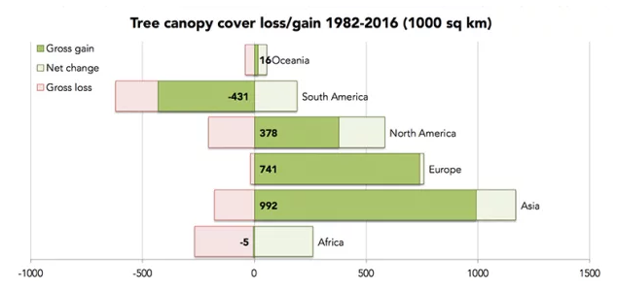Earth has more trees than it did 35 years ago - but there’s a huge catch

But an important distinction needs to be made between tree cover and forest cover. Image: REUTERS/Nacho Doce

Get involved with our crowdsourced digital platform to deliver impact at scale
Stay up to date:
Future of the Environment
News headlines report a world constantly beset by deforestation and desertification, but new research suggests the planet may not be as tree-damaged as once thought.
Although agricultural expansion in the tropics has swallowed vast areas of the rainforest, climate change has allowed a greater number of new trees to grow in areas previously too cold to support them.
Scientists at the University of Maryland analysed satellite pictures showing how the use of land on Planet Earth has altered over a 35-year period. The study, published in Nature journal, is the largest of its kind ever conducted.
The research suggests an area covering 2.24 million square kilometers - roughly the combined land surface of Texas and Alaska, two sizeable US states - has been added to global tree cover since 1982. This equates to 7% of the Earth’s surface covered by new trees.
But what may sound like good news for the planet actually represents mixed news for the environment.
Going against the grain
The findings may appear to contradict the long-established view that forests are being destroyed. A report from the UN’s Food and Agriculture Organization, for example, says there has been a net loss of 1.29 million square kilometers of forest between 1990 and 2015.
The Nature study’s lead scientists Xiao-Peng Song and Matthew Hansen agree the planet has lost large expanses of tree area, largely in the tropics.
They recorded 1.33 million square kilometers of fallen tree cover between 1982 and 2016, mostly through land clearance for agriculture, forestry and urban development. But they also point to tree cover gains that more than compensate for the loss.
As shown in the chart above, large tree losses in Brazil were balanced by canopy gains in Europe, Asia and North America. Russia, for example, added 790,000 square kilometers, while China added 324,000 square kilometers.
Agricultural abandonment in Europe, Asia and North America, together with tree planting programmes in places like China have also driven canopy growth.
And rising temperatures have enabled forested areas to flourish closer to the poles causing canopy cover to expand. Grasses, shrubs and trees can now thrive even in deserts, mountain regions and tundra.
Lost in the woods
However, an important distinction needs to be made between tree cover and forest cover.
The study points out that industrial timber plantations, mature oil palm estates and other specifically planted forests add to global tree cover. On paper these areas compensate for the primary forest that has been cut down; 100-hectare loss of primary forest is perfectly offset by a 100-hectare gain on a man-made plantation, for example.
But while they may be equal in area, they are not equal in biodiversity. Primary tropical forests and savannas harbour a wealth of flora and fauna which is lost when these areas are cleared.
And man-made forests do not compensate for the damage and degradation done to ecosystems through land clearance.
The research attributes 60% of all land-use change throughout the study period directly to human activity, with the remaining 40% caused by indirect factors like climate change.
As the Earth turns increasingly green it could be masking the true extent of environmental harm caused by human activity.
Don't miss any update on this topic
Create a free account and access your personalized content collection with our latest publications and analyses.
License and Republishing
World Economic Forum articles may be republished in accordance with the Creative Commons Attribution-NonCommercial-NoDerivatives 4.0 International Public License, and in accordance with our Terms of Use.
The views expressed in this article are those of the author alone and not the World Economic Forum.
Related topics:
The Agenda Weekly
A weekly update of the most important issues driving the global agenda
You can unsubscribe at any time using the link in our emails. For more details, review our privacy policy.
More on Nature and BiodiversitySee all
Dan Lambe
April 24, 2024
Roman Vakulchuk
April 24, 2024
Charlotte Kaiser
April 23, 2024
Jennifer Holmgren
April 23, 2024
Agustin Rosello, Anali Bustos, Fernando Morales de Rueda, Jennifer Hong and Paula Sarigumba
April 23, 2024
Carlos Correa
April 22, 2024







